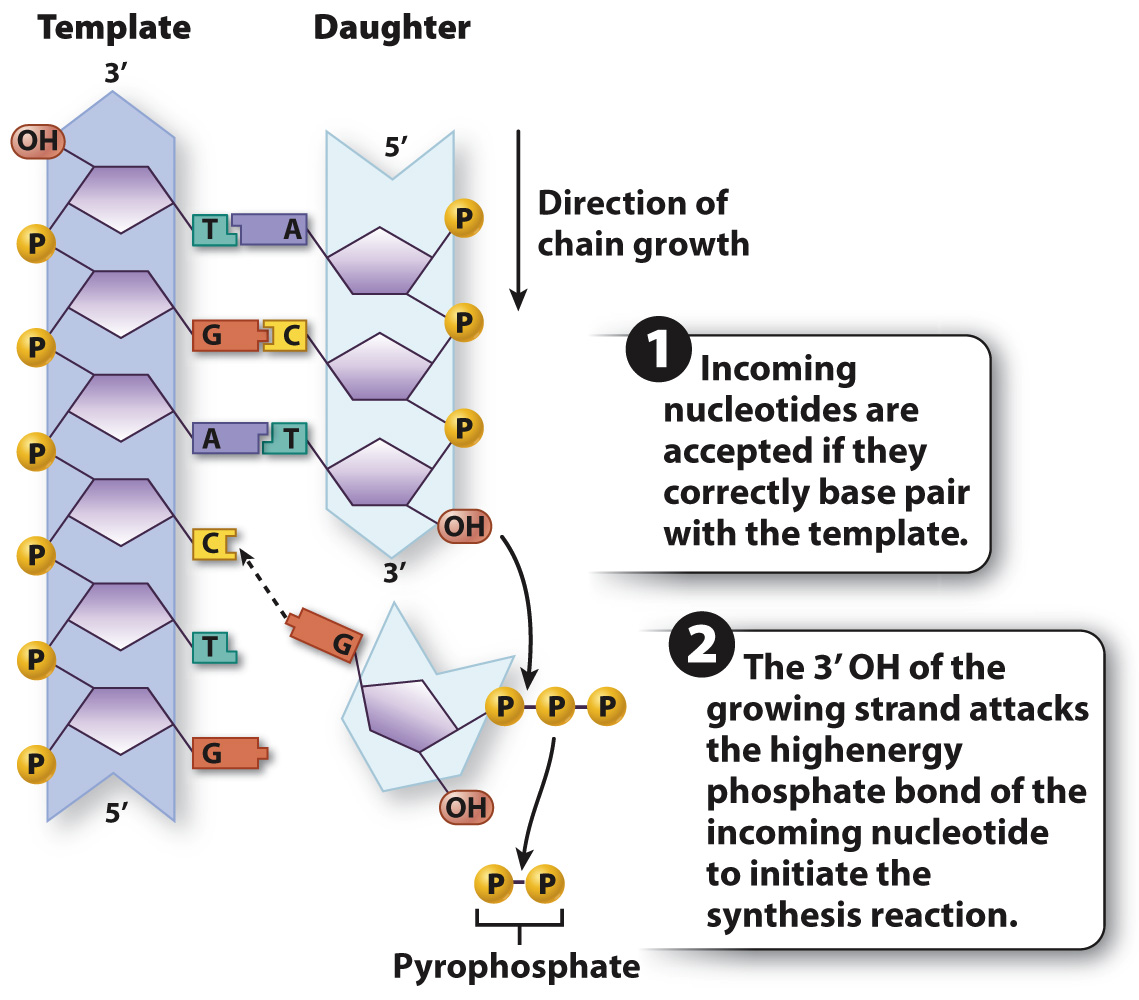New DNA strands grow by the addition of nucleotides to the 3′ end.
Although replication is semiconservative, this model alone does not tell us the details of replication. For example, the model implies that both daughter strands should grow in length by the addition of nucleotides near the site where the parental strands separate, a site called the replication fork. As more and more parental DNA is unwound and the replication fork moves forward (to the left in Fig. 12.1), both new strands would also grow in the direction of replication fork movement. But it turns out that this scenario is impossible.
We have seen that the two DNA strands in a double helix run in an antiparallel fashion: One of the template strands (the bottom one in Fig. 12.1) has a left-to-right 5′-to-3′ orientation, whereas the other template strand (the top one in Fig. 12.1) has a left-to-right 3′-to-5′ orientation. Therefore, the new daughter strands also have opposite orientations, so that near the replication fork the daughter strand in the bottom duplex terminates in a 3′ hydroxyl, whereas that in the top duplex terminates in a 5′ phosphate. There’s the rub: The strand that terminates in the 5′ phosphate cannot grow in the direction of the replication fork because new DNA strands can grow only by the addition of successive nucleotides to the 3′end. That is, DNA always grows in the 5′-to-3′ direction.
DNA polymerization occurs only in the 5′-to-3′ direction because of the chemistry of nucleic acid synthesis, discussed in Chapter 3. The building blocks of DNA (Chapter 2) are nucleotides, each consisting of a deoxyribose sugar with three phosphate groups attached to the 5′ carbon, a nitrogenous base (A, T, G, or C) attached to the 1′ carbon, and a free hydroxyl (–OH) group attached to the 3′ carbon. DNA polymerization occurs when the 3′ hydroxyl at the growing end of the polynucleotide chain attacks the triphosphate group at the 5′ end of an incoming nucleotide (Fig. 12.4). Each of these incoming nucleotides is a nucleotide triphosphate (three phosphate groups attached to the 5′ carbon of the deoxyribose). As the incoming nucleotide triphosphate is added to the growing DNA strand, one of the nucleotide’s high-energy phosphate bonds is broken to release the outermost two phosphates (called pyrophosphate), and immediately the high-energy phosphate bond in the pyrophosphate is cleaved to drive the polymerization reaction forward and make it irreversible.

FIG. 12.4 DNA synthesis by nucleotide addition to the 3′ end of a growing DNA strand.
Page 251
The polymerization reaction is catalyzed by DNA polymerase, an enzyme that is a critical component of a large protein complex that carries out DNA replication. DNA polymerases exist in all organisms and are highly conserved, meaning that they vary little from one species to another because they carry out an essential function. A cell typically contains several different DNA polymerase enzymes, each specialized for a particular situation. But all DNA polymerases share the same basic function in that they synthesize a new DNA strand from an existing template. Most, but not all, also correct mistakes in replication, as we will see. DNA polymerases have many practical applications in the laboratory, which we will discuss later in this chapter.
